By Kathy Lien, Managing Director of BK Asset Management.
If we compare where the Australian and New Zealand dollars were at the beginning and end of 2015, it would be easy to conclude that it has been a terrible year for both currencies. AUD and NZD were the second- and third-worst performing major currencies, losing approximately 10% of their value against the U.S. dollar. However in the last 3 months of the year, NZD and AUD became the best performers with NZD/USD rising more than 7%. That turnaround has many investors wondering if these 2 commodity currencies have finally bottomed.
To address this question we recognize the 3 primary factors affecting AUD and NZD in 2015 -- the U.S. dollar, commodity prices and China. In the first 9 months of the year, AUD and NZD were hit hard by a stronger dollar, weaker Chinese growth and falling commodity prices. Toward the end of the year the U.S. dollar lost momentum and the market found new appetite for high-yield currencies. The Reserve Banks of Australia and New Zealand, which cut interest rates earlier in the year also expressed optimism about their economies, leading investors to believe that they were done easing. In December, the price of Australia's and New Zealand’s two most important exports -- Iron ore and dairy -- bottomed, adding to the recovery in these commodity currencies.
In 2016, these same 3 factors will continue to dictate the direction for AUD and NZD. We are looking for further U.S. dollar gains in the first half of the year but it will be a bumpy road. After raising interest rates for the first time in 9 years, the Federal Reserve could now take a break before considering another rate hike in March. That gives AUD and NZD some breathing room to recover, but a true bottom may not be in place until the Fed slows down its pace of tightening. So in the meantime, the focus will be on China and commodity prices.
There are two ways that China could make life difficult for Australia and New Zealand in 2016. China has been extremely vocal about its plans to shift from a manufacturing- to a services-driven (consumption) economy -- a process that has played a key role in slowing growth. Now that China has won inclusion in the IMF’s SDR basket, it could return to easier policy and allow for a weaker currency to support the recovery. In the short run this will hurt countries like Australia and New Zealand who rely on Chinese demand because a lower currency diminishes Chinese purchasing power. But in the long run, it will benefit significantly from China’s goal of becoming a consumption-driven economy. Currently, less than 2% of Chinese workers earn enough to pay income tax but if those 770 million people start to see wages rise, their purchasing power could far surpass the 146 million Americans in the poor-but-working-class category. Chinese rebalancing is expected to continue in 2016 and while the official numbers may not look so bad, there’s a reasonable chance that real underlying growth will be lower. At the onset, slower Chinese growth will mean weaker demand for commodities, hurting countries like Australia and New Zealand but the PBoC is likely to respond with more stimulus, which could soften the blow for the region.
In other words, while we expect AUD and NZD to outperform many major currencies, their rebound versus the dollar could run out of steam in the first quarter as the Fed resumes tightening. The second half should be brighter for both countries and their currencies as the Fed slows its pace of tightening and China increases stimulus.
Between the two, Australia is more vulnerable than New Zealand to slower Chinese growth because Australia’s economy is more heavily focused on the investment side and more sensitive to the turmoil in global commodity prices and the impact of the stronger U.S. dollar. New Zealand also relies heavily on Chinese demand but it focuses on the consumer and their demand for food supplies. New Zealand is also a smaller economy so growth in tourism can have a larger impact on activity. In 2015, big-spending tourists helped the economy grow faster than expected and while Australia also saw a rise in tourism, it represents a smaller percent of GDP. In other words we expect further weakness in AUD/NZD.
The price of dairy -- New Zealand’s prized commodity -- also experienced a stronger turnaround than iron ore, Australia’s top export. By the end of 2015, iron ore prices were down -30%, copper prices down -23% and gold -9%. Dairy on the other hand was only 9% cheaper than last year, which represents a significant recovery from August when prices were down as much as 33%. We continue to see signs of a bottom in dairy, which helped stage a stronger recovery in the third and fourth quarters. Australia also bounced back in Q3 but the key to the economy’s recovery is the government’s ability to reduce its dependence on resources. With the opening of a new financial district on Sydney’s waterfront, Australia is hoping to become the next major Asian financial hub. While the A$7 billion project will be completed in 2023, the first few skyscrapers housing big names such as KPMG and HSBC will open in 2016.
In the meantime, we do not see the need for further easing by the RBA and RBNZ in the coming year. The RBA lowered interest rates by 50bp in 2015 and the RBNZ cut 25bp three meetings in a row. Aside from providing important support to the economy, those efforts drove the Australian and New Zealand dollars to a lower, more satisfactory level. As dairy prices recover at a faster pace than iron ore, we expect New Zealand to outperform Australia, especially in the first half of the year.
Technically, we're looking for a further bounce in AUD/USD and NZD/USD before the March FOMC meeting and a pullback thereafter. AUD/USD should hit at least 75 cents although the main resistance is 0.7850 -- the 200-month SMA. For NZD/USD, we are looking for the rally to extend to 73 cents, the 38.2% Fibonacci retracement of the 2009-to-2011 rally.


